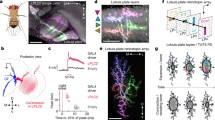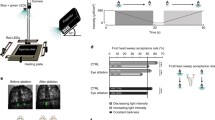Abstract
We study the extent to which the lateral ocelli of dragonflies are able to resolve and map spatial information, following the recent finding that the median ocellus is adapted for spatial resolution around the horizon. Physiological optics are investigated by the hanging-drop technique and related to morphology as determined by sectioning and three-dimensional reconstruction. L-neuron morphology and physiology are investigated by intracellular electrophysiology, white noise analysis and iontophoretic dye injection. The lateral ocellar lens consists of a strongly curved outer surface, and two distinct inner surfaces that separate the retina into dorsal and ventral components. The focal plane lies within the dorsal retina but proximal to the ventral retina. Three identified L-neurons innervate the dorsal retina and extend the one-dimensional mapping arrangement of median ocellar L-neurons, with fields of view that are directed at the horizon. One further L-neuron innervates the ventral retina and is adapted for wide-field intensity summation. In both median and lateral ocelli, a distinct subclass of descending L-neuron carries multi-sensory information via graded and regenerative potentials. Dragonfly ocelli are adapted for high sensitivity as well as a modicum of resolution, especially in elevation, suggesting a role for attitude stabilisation by localization of the horizon.










Similar content being viewed by others
Abbreviations
- BFD:
-
Back focal distance
- LCD:
-
Liquid crystal display
- L-neuron:
-
Large second-order ocellar neuron
- LED:
-
Light emitting diode
- PSL:
-
Posterior slope
- S-neuron:
-
Small second-order ocellar neuron
- UV:
-
Ultraviolet
References
Berry R, Stange G, Olberg R, van Kleef J (2006) The mapping of visual space by identified large second-order neurons in the dragonfly median ocellus. J Comp Physiol A 192:1105–1123
Berry RP, Stange G, Warrant EJ (2007a) Form vision in the insect dorsal ocelli: an anatomical and optical analysis of the dragonfly median ocellus. Vis Res (in press)
Berry RP, Warrant EJ, Stange G (2007b) Form vision in the insect dorsal ocelli: an anatomical and optical analysis of the locust ocelli. Vis Res (in press)
Campbell FW, Green DG (1965) Optical and retinal factors affecting visual resolution. J Physiol 181:576–593
Campbell FW, Gubisch RW (1966) Optical quality of the human eye. J Physiol 186:558–578
Chahl J, Thakoor S, Le Bouffant N, Stange G, Srinivasan MV, Hine B, Zornetzer S (2003) Bioinspired engineering of exploration systems: a horizon sensor/attitude reference system based on the dragonfly ocelli for Mars exploration applications. J Robotic Syst 20(1):35–42
Chappell RL, Dowling JE (1972) Neural organization of the median ocellus of the dragonfly. I. Intracellular electrical activity. J Gen Physiol 60:121–147
Chappell RL, Goodman LJ, Kirkham JB (1978) Lateral ocellar nerve projections in the dragonfly brain. Cell Tissue Res 190:99–114
Cornwell PB (1955) The functions of the ocelli of Calliphora (Diptera) and Locusta (Orthoptera). J Exp Biol 32:217–237
Goodman LJ (1981) Organisation and physiology of the insect dorsal ocellar system. In: Autrum H (eds) Handbook of sensory physiology, Vol VII 6C. Springer, Berlin, pp 201–286
Homann H (1924) Zum Problem der Ocellenfunktion bei den Insekten. Z Vergl Physiol 1:541–578
Homberg U, Christensen TA, Hildebrand JG (1989) Structure and function of the deutocerebrum in insects. Annu Rev Entomol 34:477–501
James AC, Ruseckaite R, Maddess T (2005) Effect of temporal sparseness and dichoptic presentation on multifocal visual evoked potentials. Vis Neur 22:45–54
Kondo H (1978) Efferent system of the lateral ocellus in the dragonfly: Its relationships with the ocellar afferent units, the compound eyes, and the wing sensory system. J Comp Physiol A 125:341–349
Labhart T, Nilsson D-E (1995) The dorsal eye of the dragonfly Sympetrum: specializations for prey detection against the blue sky. J Comp Physiol A 176:437–453
Land MF (1981) Optics and vision in invertebrates. In:Autrum H (ed) Handbook of sensory physiology, Vol VII 6B. Springer, Berlin, pp 471–592
Milde J, Homberg U (1984) Ocellar interneurons in the honeybee: characteristics of spiking L-neurons. J Comp Physiol A155:151–160
Mizunami M (1994). Functional diversity of neural organization in insect ocellar systems. Vision Res 35:443–452
Mobbs PG, Guy RG, Goodman LJ, Chappell RL (1981) Relative spectral sensitivity and reverse Purkinje shift in identified L-neurons of the ocellar retina. J Comp Physiol A 144:91–97
Neumann TR, Bülthoff HH (2002) Behaviour-oriented vision for biomimetic flight control. In: Proceedings of the EPSRC/BBSRS international workshop on biologically inspired robotics 14–16, pp 196–203
Parry DA (1947) The function of the insect ocellus. J Exp Biol 24:211–219
Parsons MM, Krapp HG, Laughlin SB (2006) A motion-sensitive neurone responds to signals from the two visual systems of the blowfly, the compound eyes and ocelli. J Exp Biol 209:4464–4474
Patterson JA, Chappell RL (1980) Intracellular responses of procion filled cells and whole nerve cobalt impregnation in the dragonfly median ocellus. J Comp Physiol A 139:25–39
Rosser BL (1974) A study of the afferent pathways of the dragonfly lateral ocellus from extracellularly recorded spike discharges. J Exp Biol 60:135–160
Ruck P (1958) A comparison of the electrical responses of compound eyes and dorsal ocelli in four insect species. J Insect Physiol 2:261–274
Ruck P (1961a) Electrophysiology of the insect dorsal ocellus. I. Origin of the components of the electroretinogram. J Gen Physiol 44:605–627
Ruck P (1961b) Electrophysiology of the insect dorsal ocellus. II. Mechanism of generation and inhibition of impulses in the ocellar nerve of dragonflies. J Gen Physiol 44:629–639
Ruck P, Edwards GA (1964) The structure of the insect dorsal ocellus. I. General organization of the ocellus in dragonflies. J Morphol 115:1–26
Schachtner J, Schmidt M, Homberg U (2005) Organization and evolutionary trends of primary olfactory brain centers in Tetraconata (Crustacea + Hexapoda). Arthropod Struct Dev 34:257–299
Schuppe H, Hengstenberg R (1993) Optical properties of the ocelli of Calliphora erythrocephala and their role in the dorsal light response. J Comp Physiol A 173:143–149
Simmons PJ (1982a) The operation of connexions between photoreceptors and large second-order neurons in dragonfly ocelli. J Comp Physiol 149:389–398
Simmons PJ (1982b) Transmission mediated with and without spikes at connexions between large second-order neurones of locust ocelli. J Comp Physiol A 147:401–414
Stange G, Howard J (1979) An ocellar dorsal light response in a dragonfly. J Exp Biol 83:351–355
Stange G (1981) The ocellar component of flight equilibrium control in dragonflies. J Comp Physiol A 141:335–347
Stange G, Stowe S, Chahl JS, Massaro A (2002) Anisotropic imaging in the dragonfly median ocellus: a matched filter for horizon detection. J Comp Physiol A 188:455–467
Taylor CP (1981) Contribution of compound eyes and ocelli to steering of locusts in flight. I. Behavioural analysis. J Exp Biol 93:1–18
van Kleef J, James AC, Stange G (2005) A spatiotemporal white noise analysis of photoreceptor responses to UV and green light in the dragonfly median ocellus. J Gen Physiol 126:481–497
Warrant EJ, Kelber A, Wallén R, Wcislo WT (2006) Ocellar optics in nocturnal and diurnal bees and wasps. Arthropod Struct Dev (in press)
Warrant EJ, McIntyre PD (1993) Arthropod eye design and the physical limits to spatial resolving power. Prog Neurobiol 40:413–461
Warrant EJ, Nilsson D-E (1998) Absorption of white light in photoreceptors. Vision Res 38(2):195–207
Weber G, Renner M (1976) The ocellus of the cockroach Periplanta americana (Blattariae). Receptor area. Cell Tissue Res 168:209–222
Wehner R (1981) Spatial vision in arthropods. In: Autrum H (ed) Handbook of sensory physiology, Vol VII 6C. Springer, Berlin, pp 287–616
Wilson M (1978) The functional organisation of locust ocelli. J Comp Physiol A 124:297–316
Zenkin GM, Pigarev IN (1971) Optically determined activity in the cervical nerve chain of the dragonfly. Biofizika 16:299–306
Acknowledgments
This work was sponsored by the Air Force Office of Scientific Research (AFOSR), contract AOARD−03–4009. We thank Dr. Michael Ibbotson for providing some of the necessary software to generate three-dimensional reconstructions. The experiments described herein comply with guidelines supplied by the Animal Experimentation Ethics Committee of the Australian National University, and also with the current laws of Australia, where the experiments were performed.
Author information
Authors and Affiliations
Corresponding author
Rights and permissions
About this article
Cite this article
Berry, R., van Kleef, J. & Stange, G. The mapping of visual space by dragonfly lateral ocelli. J Comp Physiol A 193, 495–513 (2007). https://doi.org/10.1007/s00359-006-0204-8
Received:
Revised:
Accepted:
Published:
Issue Date:
DOI: https://doi.org/10.1007/s00359-006-0204-8




